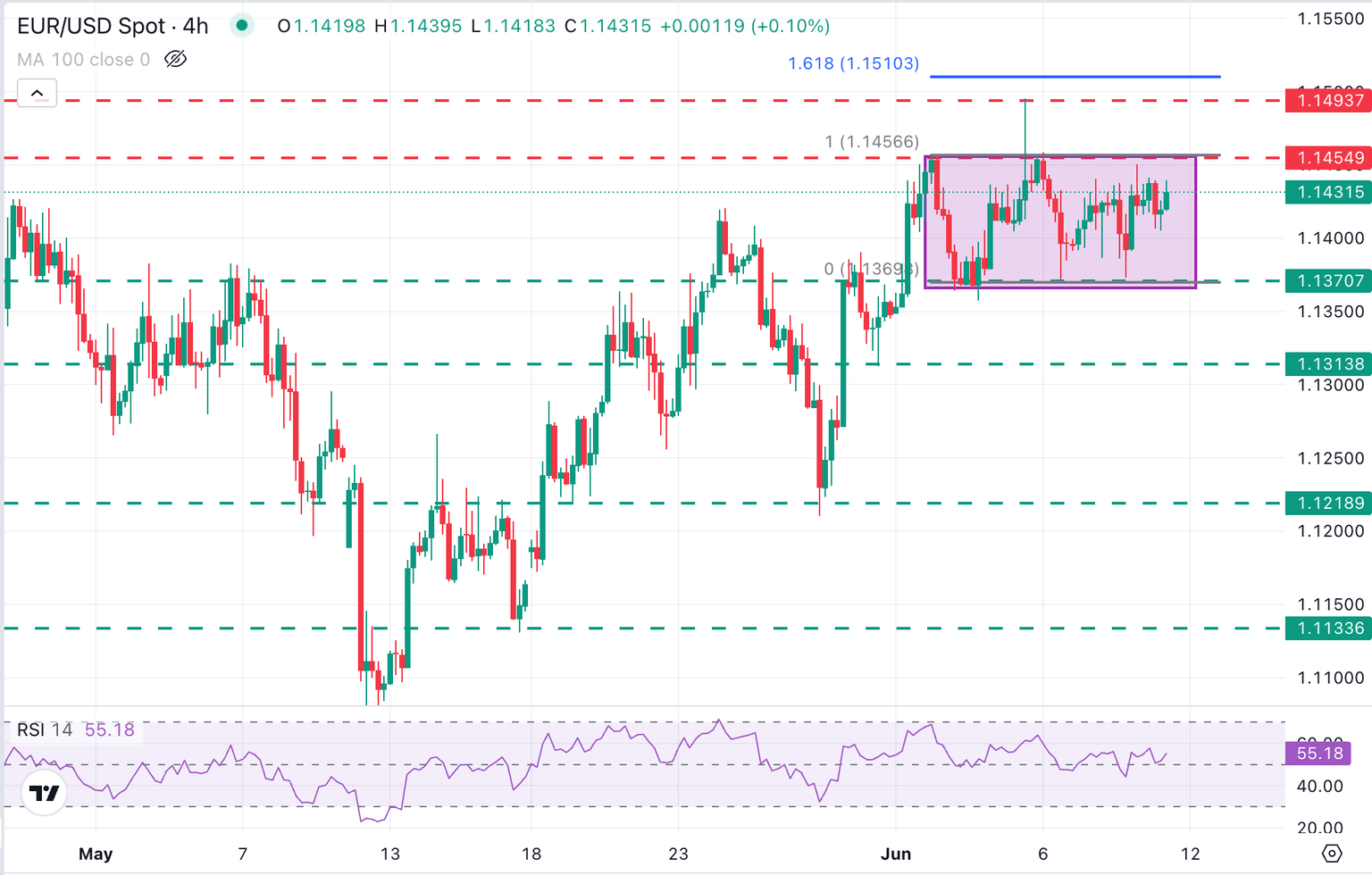EUR/USD wavers in previous ranges with markets cautious ahead of the US CPI
- The Euro remains steady, with investors sceptical about the US-China deal.
- The US Dollar has given away previous gains ahead of the release of US CPI data.
- EUR/USD remains indecisive, looking for direction between 1.1375 and 1.1455.

EUR/USD has retraced previous losses during the early European session and is trading at 1.1435 at the moment of writing, nearing the top of the recent range, at 1.1455. The US Dollar has given away all the ground taken on the back of news about a Sino-US agreement to reduce trade tariffs.
The deal, which brings both countries back to the consensus of last month’s talks in Geneva, still needs the ratification of US President Donald Trump and Chinese Premier Xi Jinping.
Details of the accord have been scarce, and the market has reacted with scepticism. The pair’s reaction remains constrained within the same range between 1.1375 and 1.1455 seen over the last two weeks.
Beyond that, a US federal court said that Trump’s most sweeping tariffs will remain in effect temporarily, at least until the judges decide on an initial lower court decision that ruled them illegal a few weeks ago.
On the economic calendar front, the highlight will be May’s US Consumer Price Index (CPI) data due later in the day, which is expected to show that inflation accelerated moderately and might revive fears of stagflation.
Euro PRICE Today
The table below shows the percentage change of Euro (EUR) against listed major currencies today. Euro was the strongest against the New Zealand Dollar.
| USD | EUR | GBP | JPY | CAD | AUD | NZD | CHF | |
|---|---|---|---|---|---|---|---|---|
| USD | -0.03% | 0.09% | 0.31% | 0.10% | 0.29% | 0.49% | 0.03% | |
| EUR | 0.03% | 0.11% | 0.33% | 0.10% | 0.31% | 0.46% | 0.05% | |
| GBP | -0.09% | -0.11% | 0.20% | 0.02% | 0.22% | 0.36% | -0.07% | |
| JPY | -0.31% | -0.33% | -0.20% | -0.32% | -0.01% | 0.15% | -0.32% | |
| CAD | -0.10% | -0.10% | -0.02% | 0.32% | 0.23% | 0.36% | -0.10% | |
| AUD | -0.29% | -0.31% | -0.22% | 0.01% | -0.23% | 0.14% | -0.27% | |
| NZD | -0.49% | -0.46% | -0.36% | -0.15% | -0.36% | -0.14% | -0.43% | |
| CHF | -0.03% | -0.05% | 0.07% | 0.32% | 0.10% | 0.27% | 0.43% |
The heat map shows percentage changes of major currencies against each other. The base currency is picked from the left column, while the quote currency is picked from the top row. For example, if you pick the Euro from the left column and move along the horizontal line to the US Dollar, the percentage change displayed in the box will represent EUR (base)/USD (quote).
Daily digest market movers: Markets are cautious ahead of US CPI figures
- The trade negotiations between the US and China have ended with a framework that, in the best of cases, brings the situation back to last month´s Geneva consensus. The market reaction has been far from enthusiastic.
- The focus on Wednesday will be on the US CPI figures, which are expected to have increased steadily at a 0.2% pace month-over-month in May, with the yearly inflation accelerating to 2.5% from 2.3% in the previous month.
- The market will be particularly attentive to deviations in consumer inflation, as it will determine the Federal Reserve’s (Fed) near-term monetary policy plans. Futures markets anticipate that the central bank will keep interest rates on hold in June and July, but they are evenly split about September’s decision.
- Apart from that, a $39 billion auction of US 10-year Treasury bonds will be observed with interest amid increasing concerns about US fiscal stability. The main focus will be on the demand from indirect bidders, which amounted to 71% of May’s auction. A significant decline in it might increase bearish pressure on the US Dollar.
- European data released on Tuesday revealed a larger-than-expected improvement in investors' confidence, which rose to a 0.2 reading in June, up from a -8.1 in May and a -19.5 in April, boosted by brighter expectations about the Eurozone’s economic outlook.
- European Central Bank (ECB) policymaker Olli Rehn stated that the central bank should focus on keeping inflation steady at 2% and warned about complacency over the inflation outlook. These comments echo ECB President Christine Lagarde’s remarks after last week’s meeting and curb hopes of further monetary easing in the coming month
Technical analysis: EUR/USD keeps treading water below 1.1455

EUR/USD is consolidating gains after the late-May rally, with price action trapped within an 80-pip range below 1.1455 since early June. The Relative Strength Index (RSI) is wavering around the 50 level on the 4-hour chart, but the rejection near 1.1500 last week and a bearish divergence suggest that bulls have lost momentum.
The pair is looking for direction above 1.1400 on Wednesday with key support at 1.1375 (near June 6 and 10 lows). A breach of this level is needed to confirm a deeper correction heading to 1.1315 (May 30 low) and 1.1215-1.1220 (May 28 and 20 lows).
On the upside, immediate resistance is at the June 3 high at 1.1455, ahead of the June 5 high at 1.1495.
US Dollar FAQs
The US Dollar (USD) is the official currency of the United States of America, and the ‘de facto’ currency of a significant number of other countries where it is found in circulation alongside local notes. It is the most heavily traded currency in the world, accounting for over 88% of all global foreign exchange turnover, or an average of $6.6 trillion in transactions per day, according to data from 2022. Following the second world war, the USD took over from the British Pound as the world’s reserve currency. For most of its history, the US Dollar was backed by Gold, until the Bretton Woods Agreement in 1971 when the Gold Standard went away.
The most important single factor impacting on the value of the US Dollar is monetary policy, which is shaped by the Federal Reserve (Fed). The Fed has two mandates: to achieve price stability (control inflation) and foster full employment. Its primary tool to achieve these two goals is by adjusting interest rates. When prices are rising too quickly and inflation is above the Fed’s 2% target, the Fed will raise rates, which helps the USD value. When inflation falls below 2% or the Unemployment Rate is too high, the Fed may lower interest rates, which weighs on the Greenback.
In extreme situations, the Federal Reserve can also print more Dollars and enact quantitative easing (QE). QE is the process by which the Fed substantially increases the flow of credit in a stuck financial system. It is a non-standard policy measure used when credit has dried up because banks will not lend to each other (out of the fear of counterparty default). It is a last resort when simply lowering interest rates is unlikely to achieve the necessary result. It was the Fed’s weapon of choice to combat the credit crunch that occurred during the Great Financial Crisis in 2008. It involves the Fed printing more Dollars and using them to buy US government bonds predominantly from financial institutions. QE usually leads to a weaker US Dollar.
Quantitative tightening (QT) is the reverse process whereby the Federal Reserve stops buying bonds from financial institutions and does not reinvest the principal from the bonds it holds maturing in new purchases. It is usually positive for the US Dollar.
release
Author

Guillermo Alcala
FXStreet
Graduated in Communication Sciences at the Universidad del Pais Vasco and Universiteit van Amsterdam, Guillermo has been working as financial news editor and copywriter in diverse Forex-related firms, like FXStreet and Kantox.

















